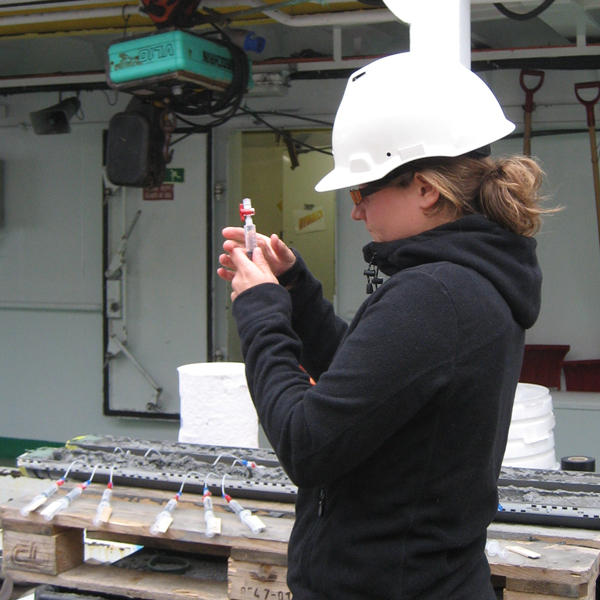Day 2
The sea remains calm, with a slight swell; the fog is impenetrable and a CTD, gravity core and ROV tour have generated enough samples to keep everyone busy.

Hovedinnhold
| Date: | 2 August 2009 |
| Weather conditions: | foggy |
| Temperature (air / water): | 9.4 / 7.2 *dew point = 8.8 |
| Wind speed: | 3.9 |
| Wave height: | very low |
| Location: | 72N 14E |
Daily report:
We arrived at the Håkon Mosby mud volcano at 9:00 this morning. Stig Monsen our senior technician was first in action with a 5m gravity core. It brought up a load of warm, fine, silty gray mud that was very porous attesting to the circulation of considerable gaseous material. The geochemists moved in after the microbiologists had taken their samples, and their little pore-water samplers were in action for the rest of the day on the stern deck.
We set out the smaller CTD to take water samples in a profile through the water column. The preliminary results indicate two layers that had high levels of methane: one near the seafloor, as expected, and another about 90m up. Marvin and his crew are eager to find out more about this second peak. Hilde Kristiansen also took some of the collected water in order to try to isolate the viruses present!
Marvin is also analysing the helium concentrations in the water. He3, or the lightest isotope of helium is not made on earth today, so any amounts found date from the formation of earth. If we find unusual concentrations of this helium isotope, it might indicate that there is mantle energy involved in the venting activity here.
Finally we set out the ROV for its maiden voyage this summer. We started at the centre of the mud volcano, a relatively desolate area in terms of visible fauna, and drove out to the rim, which is clearly marked by a small depression. Here we found much more visible life, including tiny tube worms and other typical fauna that is considered typical of cold seeps. Hans Tore's team collected numerous samples including a rarely seen ribbon worm.
Ida's team collected some sediment samples with the new push core apparatus on the ROV - its use demands some very fine dexterity on the part of the ROV pilots. They would like to learn more about the microorganism partnerships in the sediments. Several different kinds of microbial specialists seem to "work" together. This team work is actually visible in the form of thick white sulphide mats on the seafloor. Ida would like to explore the way the community structure changes with depth.
INTERESTING FACT: Viruses do not just bring illnesses to humans, there are specialised viruses that affect every type of organism - their effect on ecosystems is just beginning to be investigated!
Click on a day below to access another report!
| Sun | Mon | Tues | Wed | Thurs | Fri | Sat |
| 1 | ||||||
| Day 1 | ||||||
| 2 | 3 | 4 | 5 | 6 | 7 | 8 |
| Day 2 | Day 3 | Day 4 | Day 5 | Day 6 | Day 7 | Day 8 |
| 9 | 10 | 11 | ||||
| Day 9 | Day 10 | Day 11 |
